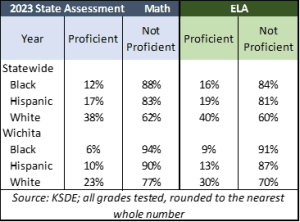(The Sentinel) — A report from the Department of Justice found pervasive evidence of discrimination in Wichita Public Schools against students based on race and disability.
KSNW-TV reports that DOJ investigated all 87 schools in the district as well as all special programs from the fall of 2020 through the spring of 2023.
The DOJ letter to the district attorney said the agency investigated the “administration of school discipline, referral of student conduct to law enforcement, and use of seclusion and restraint within Wichita Public Schools.”
DOJ found discrimination during the “relevant period” against students based on race and disability.
“In particular, we substantiated allegations that the District discriminated against Black students in its administration of school discipline and referral of student conduct to law enforcement,” the report reads. “We also found evidence that the District denied students with disabilities equal opportunity to participate in or benefit from its education program and failed to make reasonable modifications to avoid disability discrimination in its education program.”
According to DOJ, Black students are disciplined more frequently and more severely than white students who engage in similar conduct and have similar backgrounds, and the “pattern was most evident when it came to subjective and vaguely defined offenses, such as ‘disruptive conduct’ and ‘insubordination,’ and was especially stark when it came to discipline of Black girls. We also found that the District’s lack of appropriate policies, training, and monitoring likely permitted this different treatment to go unchecked.”
DOJ also found that at one Wichita high school, Black students were five times as likely as their white peers to receive a disciplinary referral and five times as likely to be suspended as a result of that referral.
At several middle and elementary schools, Black students were more than three times as likely as their white peers to be suspended.
DOJ also found that in incident reports for “insubordination” offenses across the district, Black girls were three-and-a-half times more likely than white girls to be described with stereotypical terms like “attitude” and “drama.”
“In one such incident involving a Black and white student fighting, the Black student was disciplined more severely than the white student even though the Black student was not more violent during the incident, neither student was injured, and the white student had instigated the fight by using a racial slur,” investigators wrote. “In addition, Black students in District high schools were referred to law enforcement for minor conduct even though similarly situated white students were not referred for similar conduct. This included a Black student being referred to the police for pushing another student to the ground during a game of tag in gym class, but no such referral being made when a white student in the same grade engaged in similar conduct.”
DOJ also found discrimination in the district’s over-used physical restraint and seclusion.
“The Department’s investigation also revealed that District personnel frequently relied on restraint and seclusion when responding to the conduct of students with disabilities,” according to the report. “During the Relevant Period, the District reported conducting 1,570 restraints and 1,450 seclusions. Nearly all of these incidents — 98% — involved a student with a disability. Indeed, the only schools that had dedicated seclusion rooms were schools that housed special programs for students with emotional or behavioral disabilities.”
Moreover, the DOJ found the number of restraints was likely understated because, as we learned during the investigation, prior to the 2022-23 school year, District personnel regularly failed to report involuntary physical transports of students as restraints.
“Based on our investigation, we concluded that most of the District’s restraints and all its seclusions were improper under both District policy and generally accepted practice, which limit the use of restraint and seclusion to situations involving a ‘reasonable and immediate danger of physical harm.’
“In practice, the District used restraints and seclusions in its schools when there was no safety threat, and instead to enforce school rules, to address refusals to comply with staff directives, to prevent students from leaving a room or area, and to transport students. For example, restraints were used to remove a student after he refused to take off his hat and to move a student after he kicked over a trash can and refused to pick it up, and a student was secluded for peeling paint off a school wall.”
The district has entered into a settlement agreement to address most of the discrimination issues contained in the report.
Educational discrimination persists in Wichita and across Kansas
It’s especially discouraging to see educational discrimination in Wichita and across the state 70 years after the U.S. Supreme Court addressed discrimination in Brown v. Board of Education.
 Brown outlawed having separate but equal facilities for students of color in 1954. Now, Kansas seems to have unequal educational opportunities for minorities in the same facilities.
Brown outlawed having separate but equal facilities for students of color in 1954. Now, Kansas seems to have unequal educational opportunities for minorities in the same facilities.
Across Kansas, only 12% of Black students were proficient in math on the 2023 state assessment, compared to 17% for Hispanic students and 38% for white students. In Wichita, just 6% of Black students, 10% of Hispanic students, and 23% of white students are proficient in math.
The Legislature gives over $500 million annually to school districts for additional services to students who are at risk of academic failure, but state audits in 2019 and 2023 determined that the money is not being spent “as required in state law.”

